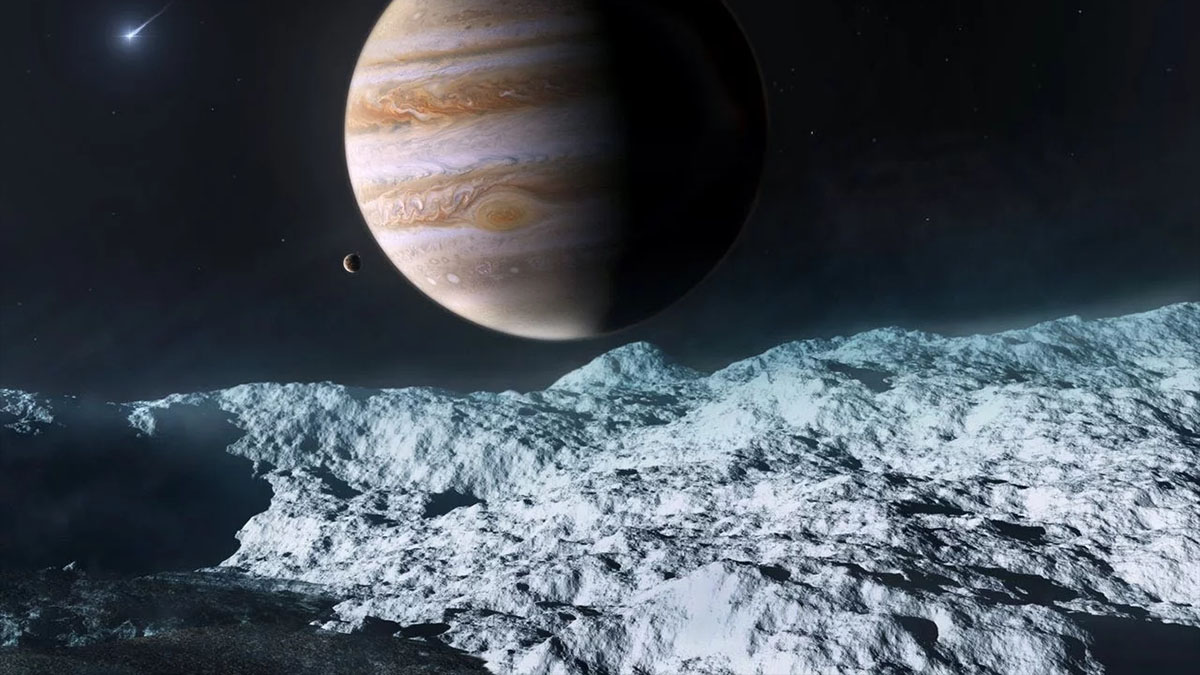the bizarre oceans of the outer solar system

The outer solar system is a strange place. It’s a realm of frozen gas giants surrounded by icy moons and yet, it’s actually home to one of the most promising destinations for alien hunters in the solar system, offering an even more convincing argument for an alien biosphere than Mars to some. We’re talking about Europa, which is currently covered by a thick, icy shell with a myriad of cracks along its surface which bring what looks like a liquid to the surface.
As our Sun dies and expands, it should eventually turn into a water world where clusters of what should be small islands could be home to alien amphibians which split their time between patrolling the beaches for washed up food, and the warm waves. Of course this scenario is still a billion years away and borrows heavily from our own evolutionary past but it is somewhat scientifically plausible over the eons…
However, just because Europa is still in its icy shell doesn’t mean that it can’t host life. In fact, a study looking at the tidal kneading the moon experiences, points to a warm ocean underneath all those glaciers and even a bit of energetic stirring under the surface, all promising indications for potential alien faunas. Oceanographer Robert Tyler ran a few simulations to account not just for the tidal forces acting on Europa as it orbits Jupiter and gravitationally interacts with the other large moons, but also its tilt.
The idea is that the tidal kneading of a moon tilted on its axis will send a slow moving but very energetic waves across is surface. The waves would be variants of Rossby waves which are triggered by the stress on rotating fluids. A tilt of just one degree with such waves slowly propagating across the ocean under Europa’s ice should create some 7.3 exajoules, the energy equivalent of 1.74 billion tons of TNT. In addition, the propagation of these waves would help Europa’s ocean churn, stirring up potential nutrients for living things.
Now, all those strong indirect hints that something very interesting and potentially living could be going on just a few miles under Europa’s ice should be taken with caution. We would only know if the moon can support an entire biosphere when we land on its surface and probe into its seas. Hopefully, something will swim up and wave its fin/tentacle/spine/antennae at the cameras, but we probably shouldn’t bet on it. Without seeing aliens outside movies and TV shows, we could easily miss something we didn’t even know was alive.
There’s also a very real possibility of forward contamination, that is sending our bacteria to other worlds on equipment which we want to use to find alien microbes. In the worst case scenario, these bacteria will taint the samples, trigger false positives on lab tests, and be a real pain for the researchers trying to separate terrestrial microbes from extraterrestrial ones. Hopefully, life on Europa has more of a similarity to jellyfish and sea anemones so we’d be able to rule out contamination thanks to the sheer size of the life forms we discover.
And interestingly enough, liquid water oceans swimming with life aren’t the only kind of fluid that’s possible in the outer solar system. Deep in the innards of Uranus and Neptune, temperatures could soar above 50,000 K and pressures could reach between 6 and 10 Mbar, or in the range of 87 to 145 million psi. Under the extreme heat and stress, the carbon layers inside the gas giants would turn into diamonds, and not just any diamonds but a dense, metallic graphite fluid with chunks of solid diamond-like material.
A thick enough layer of molten diamonds behaving like an ocean could also explain the bizarre tilts of the magnetic poles of the two planets since it would interact with the magnetic fields emanating from the core and deflect the lines that feed into the poles. Oh and just in case you might be wondering what it would be like to swim in a diamond ocean, don’t. At up to 40 million atmospheres and with temperatures about nine times hotter than the surface of the Sun, this ocean would crush your body into a tiny little clump as it vaporizes you with blistering heat…
See: Tyler, R. (2008). Strong ocean tidal flow and heating on moons of the outer planets Nature, 456 (7223), 770–772 DOI: 10.1038/nature07571
Eggert, J., et. al, (2009). Melting temperature of diamond at ultrahigh pressure Nature Physics, 6 (1), 40–43 DOI: 10.1038/nphys1438





